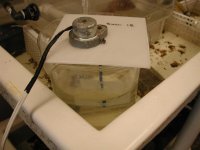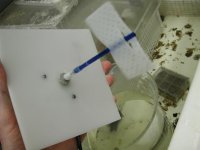This new thread pertains to the reefbowl, which is powered solely by one airstone driven by a large pump. This is the only means of circulation for the system and has been running for over a year now.
I had the reefbowl setup for some time before I was a member on any chat boards, before I got exposed to all the updated ins-and-outs of reefkeeping. I never knew micro bubbles were bad for a system (I knew they could irritate fish) until a fellow reefer saw the bowl in person at the OmniMax Science Spectrum (it was on display) and said: "Wow thats alot of fine bubbles, your corals are going to get irritated in time."
I digress. These bubbles have not caused any harm or necrotic areas in any coral that's lived in the bowl/ in fact, they play a vital role in a system that has relatively low circulation.
As corals exude slime, these bubbles (which are prominent in the water column) attach to the slime and increase buoyancy, eventually helping to lift the slime off the coral and carry it to the top of the vase where the popping airstone bubbles carry the slime out of the water and onto the upper parts of the glass. In a few places under my euphyllia, a few micro bubbles will reside under the extended tissue and this has not caused any problems in the coral, it extends just the same regardless of these hitchhikers. Until I read about microbubbles, my daughter and I liked them and though it was a neat side-effect of using an airstone for circulation! We still like them... we have no fish and I do agree this may be stressful to their gills, but as far as a CO nano/pico system go, MicroBubbles are harmless!
Just an update...
Brandon429
I had the reefbowl setup for some time before I was a member on any chat boards, before I got exposed to all the updated ins-and-outs of reefkeeping. I never knew micro bubbles were bad for a system (I knew they could irritate fish) until a fellow reefer saw the bowl in person at the OmniMax Science Spectrum (it was on display) and said: "Wow thats alot of fine bubbles, your corals are going to get irritated in time."
I digress. These bubbles have not caused any harm or necrotic areas in any coral that's lived in the bowl/ in fact, they play a vital role in a system that has relatively low circulation.
As corals exude slime, these bubbles (which are prominent in the water column) attach to the slime and increase buoyancy, eventually helping to lift the slime off the coral and carry it to the top of the vase where the popping airstone bubbles carry the slime out of the water and onto the upper parts of the glass. In a few places under my euphyllia, a few micro bubbles will reside under the extended tissue and this has not caused any problems in the coral, it extends just the same regardless of these hitchhikers. Until I read about microbubbles, my daughter and I liked them and though it was a neat side-effect of using an airstone for circulation! We still like them... we have no fish and I do agree this may be stressful to their gills, but as far as a CO nano/pico system go, MicroBubbles are harmless!
Just an update...
Brandon429







